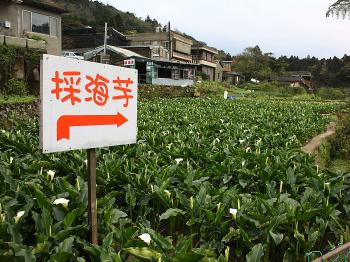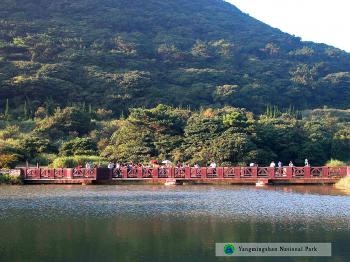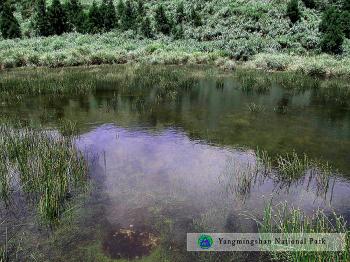“In summer, tree canopies provide shade for visitors. Water lilies of red, yellow, white, and purple float in the water with their leaves dancing in the wind. Various butterflies and playful squirrels dart among the trees …” This is the picturesque and wondrous-to-a-fault description of Yangming Mountain, otherwise known as Yangmingshan, provided on a pamphlet at the tourist office.
At first, it sounds like wild exaggeration. As you slowly meander through the park, however, it becomes clear that it is an apt description.
In a similar style to Mount Ali in the south, Yangmingshan is a National Park that has been turned into a popular tourist destination. It bustles in the spring when the flowers are blooming.
At first, Yangmingshan evokes the same feeling as other tourist spots in Taiwan, that it’s only famous because so many people visit it. Slowing wandering around the park, though, this notion quickly wears off and a genuine feeling of tranquility and serenity with the natural environment starts to set in.
At first, it sounds like wild exaggeration. As you slowly meander through the park, however, it becomes clear that it is an apt description.
In a similar style to Mount Ali in the south, Yangmingshan is a National Park that has been turned into a popular tourist destination. It bustles in the spring when the flowers are blooming.
At first, Yangmingshan evokes the same feeling as other tourist spots in Taiwan, that it’s only famous because so many people visit it. Slowing wandering around the park, though, this notion quickly wears off and a genuine feeling of tranquility and serenity with the natural environment starts to set in.
Photo Ops and Food
The main area consists of a series of gardens, ponds, bridges, flowers, and places to sit. Tourists wander around taking photos of themselves, each other, and the flowers. The centerpiece here is a large clock constructed entirely from flowers, and families take their picture in an almost constant stream. Every second person has a digital SLR camera, and every third person has a tripod to go with it.
Arrival by bus brings travelers to an intermediary area—a large car park full of coaches, a public toilet, and half a dozen food stalls with vendors hawking their wares. The lady at one of the ragtag stalls boasting nine flavors of ice cream had a horn wrapped inside a plastic bag (she explained that this is the best way to keep it from getting dirty). When a group came past she’d honk at them a few times and repeat a jingle about the corn she was selling.
The honking hawker shared the booth with an elderly man who could have been her father. He tried a different approach. He simply looked up and asked, “If you don’t by ice cream now, when will you?”
The honking hawker shared the booth with an elderly man who could have been her father. He tried a different approach. He simply looked up and asked, “If you don’t by ice cream now, when will you?”
So Much to See and Do
Beyond these two areas at the entrance to the park, there are another half-dozen different areas for the interested visitor. Few are within walking distance, so mini-buses zip around ferrying tourists to and fro. Venturing further afield, there are also a series of well-maintained hiking trails that wind through the surrounding mountains, going between lakes, hot springs, old volcanoes, and other points of note. Anyone choosing the hiking route would do well to heed the advice in a wikitravel.org entry: “Besides beautiful scenery, Yangmingshan is also famous for its poisonous snakes. Don’t go wandering off into scrub land.”
Before this park came to be, another national park was planned in the same area during Japanese colonial times. This plan was scrapped because of World War II. Notably, it was the Japanese who first developed the mountain’s tourist facilities, including the hot springs and public bathhouses. Later, another national park proposal was put up for consideration in the 60s, but again scrapped because of lack of legislative support. It was only in the early to mid-80s that the Yangmingshan National Park in its current form came to be. It covers 44 square miles, sprawling across both Taipei City and Taipei County.
Most of the tourists visiting Yangmingshan daily are Taiwanese, but the official website also has a Japanese version, and tourists from mainland China and the West can also be found here.
Before this park came to be, another national park was planned in the same area during Japanese colonial times. This plan was scrapped because of World War II. Notably, it was the Japanese who first developed the mountain’s tourist facilities, including the hot springs and public bathhouses. Later, another national park proposal was put up for consideration in the 60s, but again scrapped because of lack of legislative support. It was only in the early to mid-80s that the Yangmingshan National Park in its current form came to be. It covers 44 square miles, sprawling across both Taipei City and Taipei County.
Most of the tourists visiting Yangmingshan daily are Taiwanese, but the official website also has a Japanese version, and tourists from mainland China and the West can also be found here.
Flower Fantasia
Beyond the initial arrival and flower-clock areas, one of the other most well known spots is Jhuzihhu. Everyone that has spent the day wandering the park and eventually makes their way to this area knows that Yangmingshan is famous for a reason. Most people will arrive by bus, but the courageous—or foolhardy—will have walked over two miles, mostly uphill. For the wearied traveler, a comforting site meets the eyes.
Wandering into Jhuzihhu feels something like arriving at the Shire, that idyllic hobbit village from Tolkien’s novels. There are lush, green hills, well-kept vegetable patches with a series of paths and planks connecting them, and ponds, fountains, bridges and, most importantly, flowers.
You catch a first glimpse of the abundant calla lilies on the way to Jhuzihhu. Roadside stalls selling the delicate flower seem to appear more and more frequently, with progressively cheaper prices. Arriving at the source, you can walk among the flowers and pay a small price for picking ten lovely blossoms. Couples are a common sight at this point, as well as in the nearby restaurants.
Sitting down to a steaming-hot soup and delicious Chinese meal, looking over the fields of flowers as the sun sets, you start to get the feeling that the flyer at the tourist office is not so exaggerated after all—even if there were no squirrels to be seen.
Wandering into Jhuzihhu feels something like arriving at the Shire, that idyllic hobbit village from Tolkien’s novels. There are lush, green hills, well-kept vegetable patches with a series of paths and planks connecting them, and ponds, fountains, bridges and, most importantly, flowers.
You catch a first glimpse of the abundant calla lilies on the way to Jhuzihhu. Roadside stalls selling the delicate flower seem to appear more and more frequently, with progressively cheaper prices. Arriving at the source, you can walk among the flowers and pay a small price for picking ten lovely blossoms. Couples are a common sight at this point, as well as in the nearby restaurants.
Sitting down to a steaming-hot soup and delicious Chinese meal, looking over the fields of flowers as the sun sets, you start to get the feeling that the flyer at the tourist office is not so exaggerated after all—even if there were no squirrels to be seen.
















